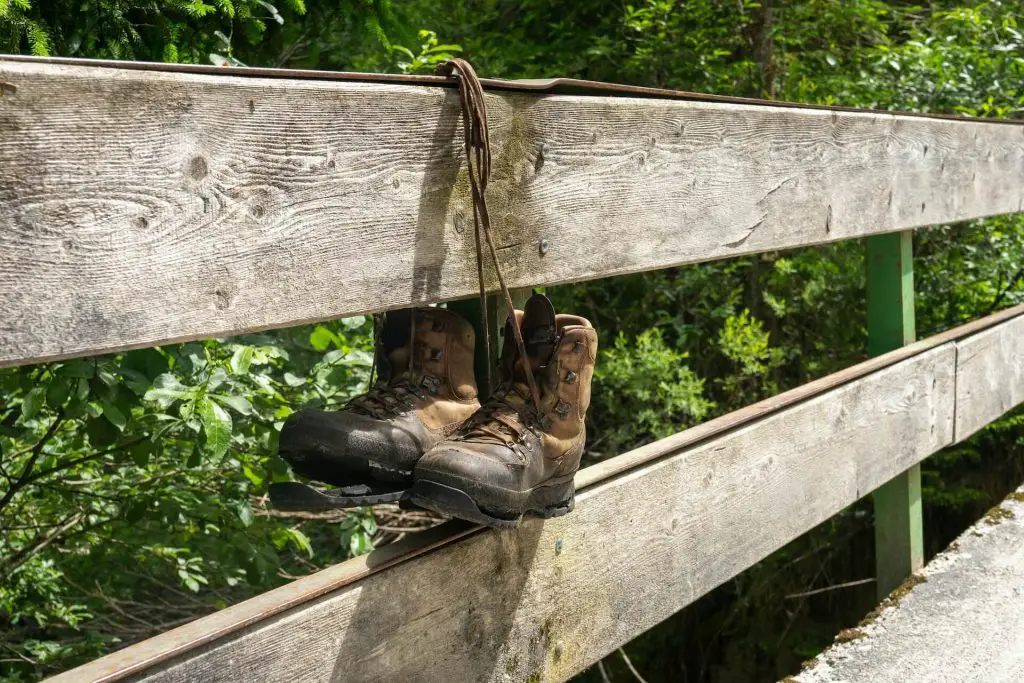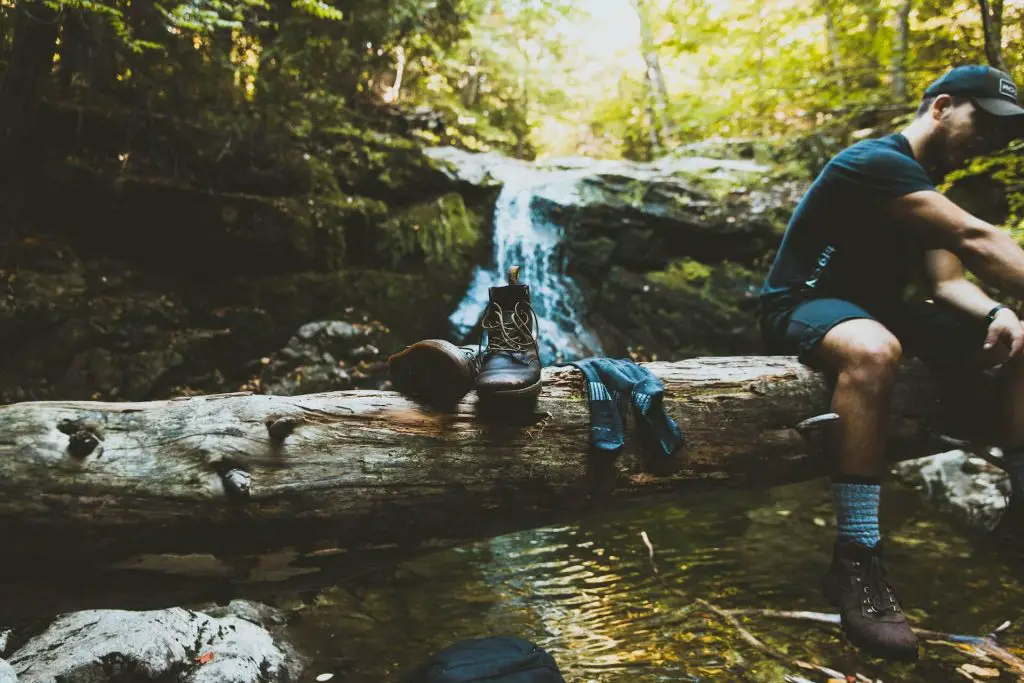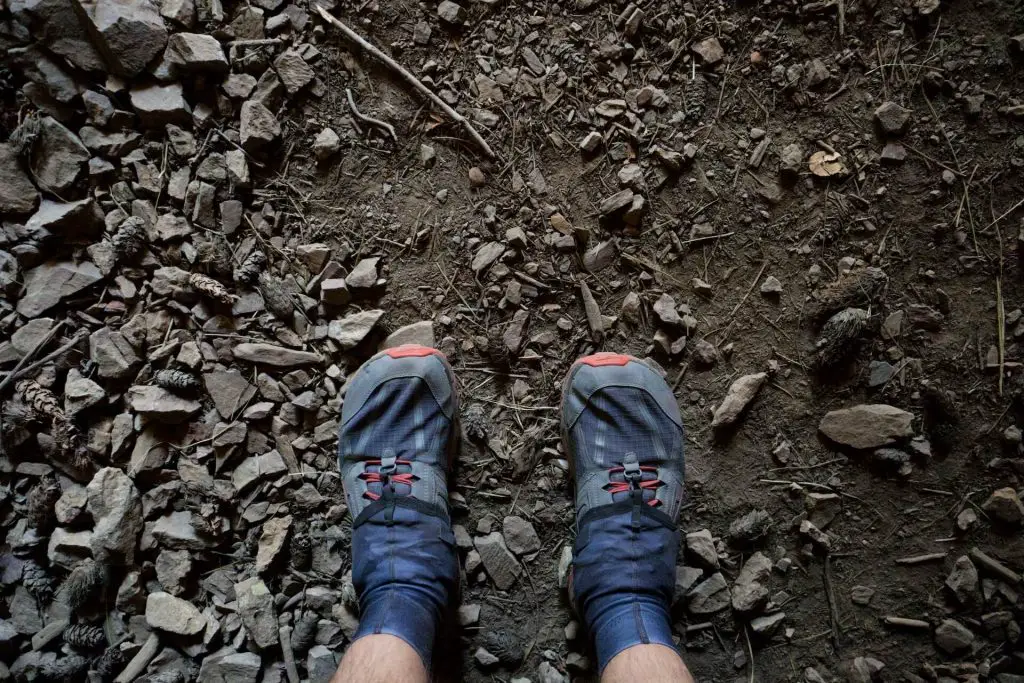
You have likely been on numerous hiking trips before and noticed your feet getting very hot and sweaty on your last hike. Having hot and sweaty feet can lead to unwanted blisters which can be very painful during a hike and slow you down drastically. What are things you can do to keep your feet from getting hot on your next hike?
To keep your feet from getting hot while hiking you can try breathable hiking shoes and use thin moisture wicking socks. Making these changes will allow more airflow to your feet which will effectively help cool them down.
I used to have excessively sweaty feet due to wearing the wrong gear on my feet. My hiking socks were the worst material and my hiking boots were not very breathable. My feet felt like a sauna on every hike I went. It wasn’t until I got advice from more experienced hikers and backpackers on the exact things to look out for when buying hiking shoes and hiking socks that my feet were finally able to cool down. Below we will go over what you should look out for hiking shoes and hiking socks and what you can do to prevent your feet from over heating.
What You Can Wear To Keep Your Feet Cool on a Hike

Hiking Shoes
The first thing you can look into changing is your hiking shoes. Are you wearing hiking boots or hiking shoes. This may be the main cause of why your feet are getting so hot. The wrong hiking shoes can have low airflow and trap all of the heat and sweat inside of your shoes. This can lead to blisters on the soles or heel of your feet.
What to Look for in Hiking Shoes
Breathability
The first thing you want to look for in a good pair of hiking shoes is breathability. Traditional hiking shoes are made of leather. The entire shoe is leather with a leather tongue on the strap. While these boots are durable, study, and will protect your feet, they have minimal airflow. All of the heat has nowhere to go which will heat up your feet quickly.
Look for shoes with mesh or materials with small holes for air. This airflow makes a huge difference to help cooling your feet. The heat has somewhere to exit from and your feet will not feel as hot. When I made the switch from old leather hiking boots to some Merrel Moab hiking boots it made a huge difference. The mesh sides of the Merrel Moabs and the soft material felt like I was walking on clouds. My feet felt much cooler and way more comfortable.
Weight
The next thing to look out for is the weight of your hiking shoes. People typically start off hiking with heavy hiking boots. This can exert your feet and leg strength throughout the day which generates even more heat. The exertion will also lead to more sweat produced by your legs and feet. All of this combined lead to even hotter feet.
Try to find a hiking boots under 2 pounds each. For hiking shoes aim to be under 1 pound each. This reduction in weight will play a huge role in how tired your feet are and how hot they get. Each step multiplied over the entire span of your trip, this weight quickly adds up. After using my Merrel Moabs for years, I discovered there are even lighter options. Eventually I switched to Altra Lone Peak which are only 11 ounces per shoe. This is more than 50% reduction in weight. Now I felt like I can hike faster and further. The Lone Peaks are incredibly breathable and lightweight.
Merrell Men’s Moab 3 Mid Waterproof Hiking Boot on Amazon
Merrell Women’s Moab 3 Mid Waterproof Hiking Boot on Amazon
Altra Lone Peak Trail Runners on Amazon
Hiking Socks
Hiking shoes are very important, but the thing that comes in direct contact with your feet are even more important. Having the wrong hiking socks can make your hike very uncomfortable. If you are like me and started hiking with the white cotton socks you wear everyday then you probably quickly realized how hot and sweaty your feet get.
You do not want to wear any cotton on a hike. No cotton shirts. cotton underwear, and especially cotton socks. Cotton is a material you should avoid during outdoor activities due to its absorbant nature. It will soak and hold all of your sweat. Each step you take on your sweaty cotton socks is an opportunity for blisters to form. Cotton will hold all of your sweat and create for a hot and steamy environment. You want to find materials that push and distribute the moisture away.
What to Look for in Hiking Socks
Material
One of the most important things to look out for when choosing hiking socks is the material. Now that you know to avoid cotton, your go-to material for hiking socks should be merino wool. While it is a bit pricier than normal socks, the cost is worth the upgrade. Merino-wool is non-absorbant and moisture-wicking.
This means that as your feet sweat your merino wool socks will help push the sweat away from your feet so they can stay dry. Having hot and moist feet is a recipe for blisters. Merino wool is also breathable so they will help your feet stay cooler with the increased airflow. I had sticker shock when I saw the price of merino wool socks when compared to your six pack of white socks from your typical store. However, once you hike with a pair of merino wool hiking socks you will immediately know it was worth every penny.
Thickness
Another important aspect to consider is the thickness and length of your hiking socks. For hiking socks you can get thin cushion, medium cushion, or very cushioned socks. The more cushion the thicker the sock. You will be trading off between comfort and how warm your feet get.
In the hot summer months you should lean towards more thin hiking socks for maximum airflow. For general hiking thin or medium cushion socks should do the job. On the colder winter months you can lean towards thicker and more cushioned socks as the cool air will help with preventing your feet from getting too hot.
Darn Tough Hiking Socks on Amazon
What Can You Do to Keep Your Feet Cool on a Hike

After getting the right hiking shoes and hiking socks, there are some other things you can do to help your feet stay cool. As you research and plan your hike you can choose when to start, how and where to take breaks, and determine your hydration plan. These three things will help your feet from not getting too hot.
Hiking Time
The first thing you can decide is when to start your hike. If the forecast says its going to be a hot day then you want to avoid hiking between noon and around three. This is typically the hottest part of the day as the sun is directly overhead and beaming on you. Typically you should try to hike in the early morning when temperatures are cooler. This will give you more time to hike in cooler weather which will help your feet from getting too hot.
Taking Breaks
The next thing you can do to help your feet from getting too hot is to research and see if there is shade on the trail. When you are taking breaks stop and take breaks in the shade if possible. Finding shade will make a huge difference as the sun isn’t hitting your feet and causing them to rise in temperature.
If you are on a very long hike then you can opt to take your shoes and socks off to give your feet some air. This will also help drastically cool down your feet in the moment.
Hydration
The third thing you can do is to properly hydrate. If its a warm day then you can add ice to your water bladder or your to an insulated water bottle. This ice cold water will help you feel cool and refreshed. This cool effect will transfer throughout your body and make your feet feel not as hot. Having cold water on a warm hike is also a great morale booster so you aren’t thinking about your feet.
Platypus Big Zip EVO Reservoir on Amazon
Hydro Flask Standard Mouth Bottle with Flex Cap on Amazon
Final Thoughts
Going out on a hike to enjoy the beautiful sights and sounds of nature is always a great choice. However, having to worry about your feet getting too hot can be distracting and deter you from ever getting out on the trails. Getting the right hiking shoes and hiking socks will help your feet stay cool and not get too hot. Having cooler feet that you don’t have to worry about will help you relax and be able to be in the moment to enjoy your next hike.
Once you have adjusted your hiking shoes and hiking socks you should also choose to hike earlier when its cooler, take breaks in the shade, and bring ice cold water. These small adjustments with your gear and your planning will make a big difference in having cooler feet that you don’t need to worry about anymore. Enjoy your next hike with the increased airflow to your feet!
